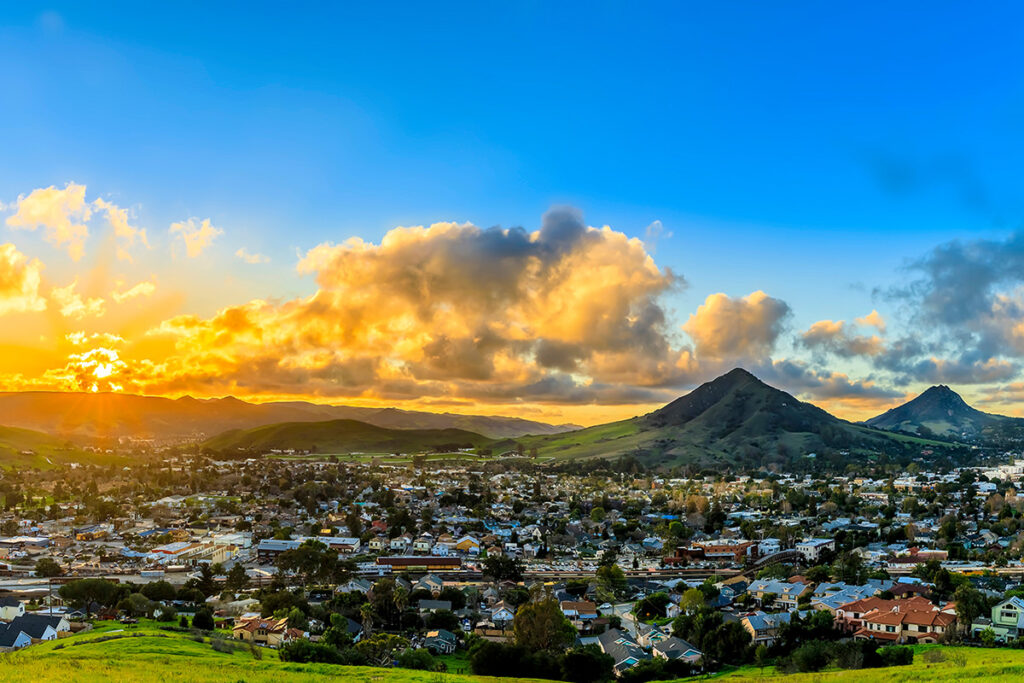Faced with unprecedented environmental challenges, the integration of climate sustainability into economic development planning has gained a sense of urgency for many practitioners. The intricate dance between advancing economic growth and championing environmental responsibility has never been more pronounced. Be it a crippling ice storm or devastating flooding event, the consequences of climate change are now more tangible for most communities. The rising number, severity, and costs of weather-related disasters have prompted governments and private industry to reevaluate practices and plan responses to these events. As further evidence of its importance, the US Economic Development Administration announced climate resilience as a requirement of the Comprehensive Economic Development Strategy Content Guidelines in April 2023.
For many in the profession, economic development and sustainability are no longer considered competing priorities. TIP’s recent work for the City of San Luis Obispo, California, (SLO or the City) provides a replicable example of the benefits of harmonizing goals for economic progress with environmental responsibility.
Committing to Sustainability
Located on California’s Central Coast, SLO is known for its scenic beauty, historic architecture, outdoor recreation, and easy accessibility to the region’s renowned vineyards. The city is also home to one of the state’s best-known higher education institutions, California Polytechnic State University, better known as Cal Poly. SLO benefits from the Central Coast’s unique topography and coastal climate. Yet, its location also makes the city particularly vulnerable to the impacts of climate change. Coastal erosion and weather-related events, such as the atmospheric rivers that brought devastating flooding to the region in early 2023, threaten the city’s residents and its economic future.
Given this vulnerability, it’s perhaps unsurprising that a commitment to sustainability is deeply woven into the city’s institutions and planning initiatives.[1] Sustainability and climate action are integrated into SLO’s Major City Goals (MCGs). This document lays out the city’s highest priorities over a two-year planning cycle. The city’s financial plan and budget spell out dedicated resources to accomplish these goals. By clearly articulating the city’s values and priorities, the MCGs helps ensure that resources and efforts are aligned across SLO’s programs and initiatives. MCGs for 2023 to 2025 are grouped under four areas:
- Climate Action, Open Space, and Sustainable Transportation
- Diversity, Equity, and Inclusion
- Economic Resiliency, Cultural Vitality, and Fiscal Sustainability
- Housing and Homelessness
In 2022, the City engaged TIP to update its economic development strategic plan (EDSP). Ensuring economic vitality through climate- and system-focused sustainable growth and maintaining a resilient economic and business environment in the face of economic disruption were among the five guiding principles that shaped the EDSP framework. The EDSP recommendations were tailored to align with SLO’s current MCGs and its longer-term considerations for growth.
Aligning Priorities
Following the completion of our work with SLO, we reached out to Lee Johnson, Economic Development Manager, and Chris Read, Sustainability Manager, for insights and lessons learned during the planning process. One theme that was evident from our exchange was the City’s view of sustainability and economic development as “mutually reinforcing priorities.”
The nexus between climate change and economic development is multifaceted.
The convergence of climate change and economic development is a complex interplay of seemingly competing priorities, but for SLO, the connection proved to be a source of opportunities. First, the City recognized a climate-focused approach to economic growth as a chance to capitalize on the clean energy transition. The shift toward clean energy technologies and infrastructure (1) increases demand for skilled labor, (2) supports job growth in high-paying sectors including engineering, construction, and research and development, and (3) stimulates innovation and technological advancements.
Second, SLO accepted that mitigating the economic shocks and disruptions precipitated by a changing climate would necessitate a comprehensive and proactive approach to resilience. Developing and implementing climate resilience plans that account for potential impacts on critical infrastructure, supply chains, and vulnerable sectors helps the City safeguard its economy against climate-related risks and vulnerabilities.
“Our big idea is that our City’s success hinges on the ability for economic development and sustainability to not be competing priorities, but rather, mutually reinforcing priorities.”
A third, and related, opportunity involved engaging the business community. The City embraced their ability to support businesses in reducing emissions while simultaneously enhancing operational resiliency. This approach recognizes that sustainability measures can be an integral component of successful business retention and expansion efforts.
Without the SLO’s commitment to alignment, these opportunities would have been missed. This alignment is reflected in the development of the high-level goals for the City’s Climate Action Plan (CAP) and EDSP, as well as its general plan which served as a unifying force by identifying both sustainability and economic development as critical to the community’s long-term health. For SLO, the general plan is the north star that has helped guarantee that both departments continue to develop and implement their respective plans collaboratively with a shared end goal in mind.
Sustainability initiatives can be designed in a way that directly complements economic and workforce priorities.
As the previous opportunities illustrate, sustainability initiatives can be designed to seamlessly complement both economic and workforce priorities. Identifying opportunities where green initiatives can directly contribute to job creation or sector growth is one example of the synergy between the two priorities. SLO created a building retrofitting initiative focused on replacing old fossil fuel appliances with new high-efficiency electric appliances. If fully implemented, the initiative is projected to bring more than $400 million in outside investments into community buildings, with a large share of those monies going to local, high-paying workers in the skilled trades. This approach supports established environmental goals, while also helping to meet SLO’s employment goals by creating job opportunities in emerging green sectors such as renewable energy, energy efficiency, and eco-friendly technologies which often pay higher wages. The City has committed to partner with regional organizations to provide the training programs and educational initiatives required to prepare its workforce for jobs in sustainable industries.
It’s easy to be distracted by short-term economic development opportunities at the expense of future vitality.
A short-sighted approach to growth opts for immediate economic benefits at the expense of future generations and disregards the long-term sustainability of economic, social, and environmental systems. Shortsightedness, whether an overreliance on a single industry or a failure to manage sprawl, can lead to the unintentional depletion of resources and environmental degradation that negatively impacts the future health and well-being of a community. A long-term vision for growth considers both immediate and future needs. Consider, for instance, the implementation of all-electric infill housing projects seamlessly integrated with active transportation infrastructure and transit systems. This approach not only enhances housing accessibility but does so with a fraction of the additional capital and operational and maintenance obligations compared to the infrastructure demands of a sprawling development pattern. Concentrating development in a more compact, efficient manner, SLO can meet its employee attraction and retention goals while preserving the surrounding green belt, safeguarding its natural ecosystems, and contributing to overall environmental resilience.
Successful implementation means revisiting and realigning on a regular basis.
Ensuring the alignment of economic development and sustainability plans extends beyond the planning phases. In fact, ensuring continued alignment is most crucial in the implementation of each plan. SLO has successfully established a process for regular review and updates of its plans to not only track progress but also to adjust to changing circumstances, emerging opportunities, or new information. The City tracks progress on its MCGs quarterly. The sustainability office’s staff reports on the CAP implementation progress to City Council on a biennial basis. The EDSP is tracked quarterly by the Economic Development and Tourism team through the implementation matrix created during our engagement and via reports to the City Council. The economic development and sustainability teams also have monthly touchpoints which supports the aim of ongoing alignment.
Some of the benefits of balancing sustainability and economic development can’t be easily quantified.
Like many aspects of economic development, a focus on sustainability and climate readiness yields benefits that cannot be easily tied to the traditional indicators of employment and capital investment. Rather, the returns need to be considered across a more comprehensive set of indicators including resource efficiency and social indicators related to health and well-being. For SLO, many of the initiatives and plans encompassed by their sustainability goals are also connected to quality of place. While this factor is somewhat intangible, it is an essential attribute in retaining and attracting investment and talent. Fostering sustainable development patterns, maximizing access to green belts and open spaces, and building an active transportation network resonate with residents, businesses, and visitors.
The impact of the increased frequency and severity of weather events is evident. It also disproportionately affects vulnerable segments of the population and intensifies existing social, economic, and health inequalities. As more economic developers work toward inclusive development, it is essential to move away from extractive economic development ideas and embrace approaches that prioritize long-term resilience, total community well-being, and environmental stewardship. Sustainable development seeks to balance economic growth with environmental responsibility and social equity to ensure a truly comprehensive approach to growth with a thriving and resilient future for communities.
[1] While sustainability is approached from multiple angles, including efforts to create secure sustainable groundwater sources and drive sustainable tourism, climate change is an overarching theme. The city’s Climate Action Plan (CAP), first published in 2020, establishes a communitywide goal of carbon neutrality by 2035. Recognized by the American Planning Association Sustainable Communities Division through its 10th Annual Awards for Excellence in Sustainability, the most recent volume of the plan outlines progress made on the implementation of prior CAP recommendations and outlines the work program for achieving goals for the current planning cycle.
Image credit: courtesy of the City of San Luis Obispo



